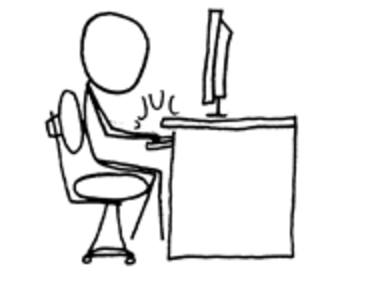
Seeing the Present from Two Points at a Time: Looking Ahead, Looking Back, and Now [UpGoer Your Book Project]
In the (delightful) spirit of UpGoer Your PhD, which itself follows in the (also delightful) footsteps of xkcd, here is an attempt (perhaps valiant, perhaps foolish) to explain my book project using only the 1000 most commonly-used English-language words—or, in upgoerspeak, “the ten hundred words people use the most often”:
The way we think about the present is changing, and it’s changing the ways we tell stories about the present and the things we use those stories for. When we fight about the present, we often end up fighting about times that are behind us or ahead of us instead. When we dream about things that might happen later on, we sometimes remember things that happened a long time in the past; when we try to make sense of things from the past, we sometimes look ahead to far-away times. When we think about what’s happening now, we have to try to think about what happened years before and what will happen years after, and it’s a lot to think about. Now more than ever, we understand the present as the place where our memories of the past meet our dreams of things that haven’t happened yet. We need to understand our stories about the present the same way, so that we can understand how our stories about things that have already happened and our stories about things that might happen later on change the way we think about our world now.
The same way things we know aren’t real change how we think about things that are real, things that happened a long time ago or that might happen a long time from now change how we think about what happens now. Our “now” is so tied to what came before and what might come after and to our ideas about those times, so our stories about “now” have also become that way. We know the way we think and talk about the past changes the way we think about the present. We know the way we think and talk about what has not happened yet changes the way we think about the present. But there’s a lot we don’t know about these ties, how they’re changing, and how they change each other.
Even when these stories aren’t true and don’t pretend to be true, they change our ideas of what a true story is, and even when these stories don’t seem to be about the present, they change our ideas of what a true story about the present should be. Because of the way we think about the present now, a true story about the present might not look like the way we think it should. It might not even look like a story about the present. It might look more like a very not-true story about times far behind or ahead of us. It might have people from the past thinking about our present in the way we think about things that might happen many years from now, or people from many years from now thinking about our present the way we think about our past. It might have strange things happening that don’t seem to have anything to do with true stories about the present, like people moving through time or the world ending or big things that happened in the real past happening in a very different way.
For the most part, we know how to talk about stories about the past, and for the most part, we know how to talk about stories about things that haven’t happened yet but might happen later. But we don’t know how to talk about the relationship between those two kinds of stories, or the way that relationship changes our ideas about the present. We don’t know how our ideas about true stories might have to change so that they fit the way we’re starting to understand the ties between now, before now, and after now. In the same way, for the most part, we know how to talk about stories that try very hard to seem real, and for the most part, we know how to talk about stories that don’t try at all to seem real. But we don’t know how to talk about the relationship between those two things, or the way that relationship has changed as our understanding of “now” has become less simple.
If we look at stories about things that might have happened long ago and stories about things that might happen many years from now and think about them together, we can understand a lot about what it means to tell stories about the present. We can see how stories that don’t try at all to seem real and stories that don’t look at all like they’re about the present might be a better way for us to think about and understand the present. And we can see how our bad ideas about true stories have kept us from understanding a lot of important things about our world.